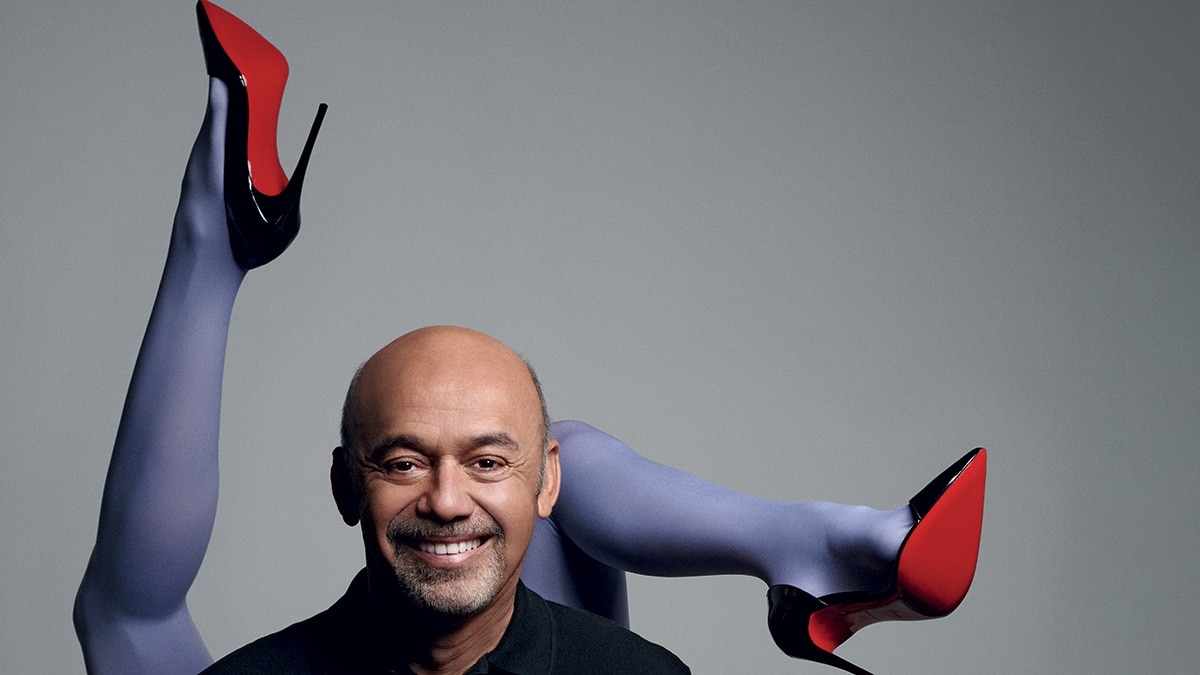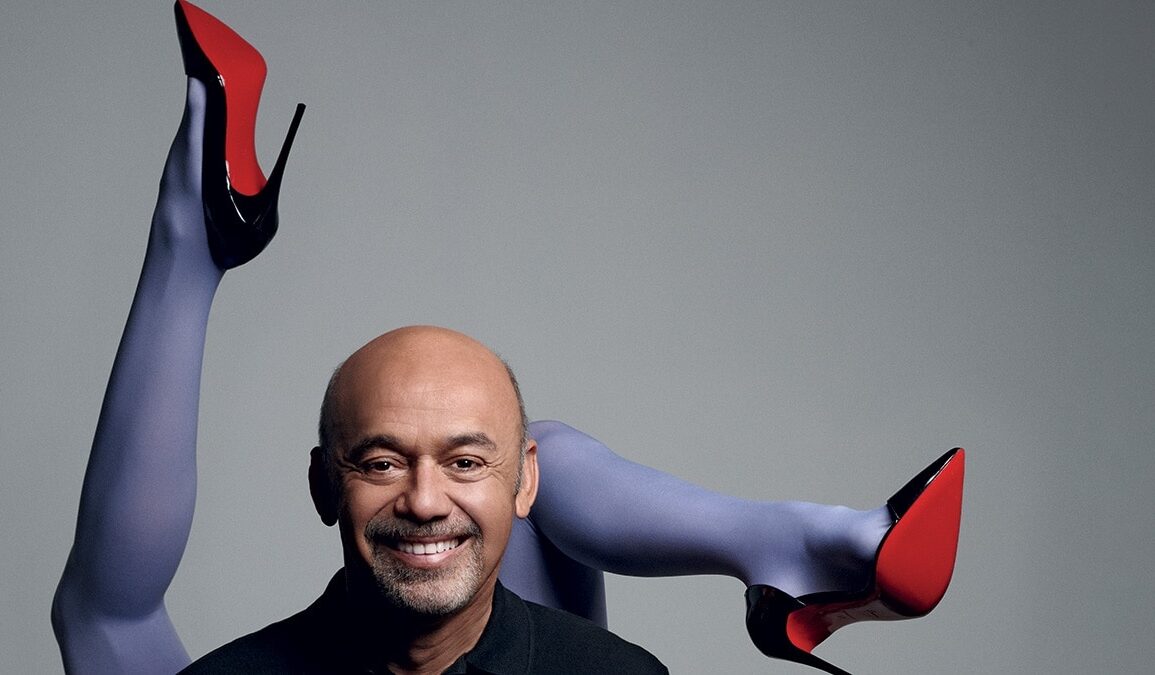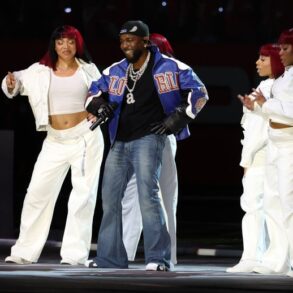
Princess Caroline of Monaco was one of Christian Louboutin’s first customers when he opened his primary boutique on Rue Jean-Jacques Rousseau in Paris’s posh Louvre District in 1991. Since then, fans of the Paris-born designer’s iconic red-soled shoes have included the late Tina Turner, Jennifer Lopez (J.Lo), Beyoncé, Sarah Jessica Parker, and Taylor Swift, and Leonardo DiCaprio as well after the maison launched his men’s footwear collection in 2010. The designer debuted his handbag collection in 2006, followed by a beauty line in 2014. Then in 2022, he launched the kids’ range, making sure that tiny feet are also adorned with the famous red-soled shoes. Today, there are 165 Christian Louboutin stores worldwide, including two in India.
“India as a country never disappoints,” he says, in a typically French-accented English drawl. “Other countries you get excited seeing a postcard, but when you reach [the country], it is not like that. India is the opposite; it is so much more than what you expect,” says Louboutin, who first visited India as a 15-year-old. His love affair with the country began with Bollywood and other Indian regional cinema that he grew up watching in the Barbados. “The first movie I saw was Satyajit Ray’s Devi with Sharmila Tagore,” he says.
Over the years he has visited India several times, and while he says that being a global brand it is not possible to launch a collection that is specific to a country’s taste, his love for India is visible in all his collections. “My love for India is in every one of my collections, I love colour,” says the 60-year-old, adding “India is so detail-oriented that you can do an India-inspired collection for a 100 years without repeating yourself.” That doesn’t stop the brand from launching capsules specific to the India market, especially to target the $50-billion Indian wedding market. “There is nothing more colourful, more extravagant, and more glamorous, than an Indian wedding,” he says. The exclusive capsule showcases a selection of the maison’s icons—10 women’s shoe styles, six men’s shoe styles and two handbags—in a gradient of metallic hues of platinum, gold and bronze. The capsule is versatile and has options in a variety of heel heights to match both western and Indian silhouettes.
Louboutin says that different collections do well in different parts of the world. For instance, his collections in Los Angeles (LA) are very different from those in New York. “No one walks in LA; it’s sunny. Whereas in New York, it’s dark and windy and everyone walks everywhere, so it’s more boots than sandals,” he explains. Indians, he says, love gold since it matches our skin tone, and also most traditional outfits and jewellery. Also, we like brighter colours. “Pastels don’t do well in India, but a strong pink which is popular here, I can’t keep in a store in London or Paris,” he says. “It’s almost like fragrances. A particular perfume may feel too strong in a cold climate, but it may feel perfectly normal in a hot climate. Similarly, bright shoes with the brightness of India work, but they come as a bit of a shock when everything around you is light-coloured,” explains Louboutin, whose red-soled shoes have an almost mythical status in popular culture. In 2009, J.Lo wrote a song ‘Louboutins’ in praise of them, and younger celebrities such as Zendaya and Bella Hadid are also fans of the shoes.
But how did the red soles come about? Over three decades ago, Louboutin was already making waves in the fashion industry with his boutique in central Paris, and many personalities were already being photographed wearing shoes designed by the stylish newcomer. But when an early prototype of a silk satin shoe named ‘Pensée’—that translates to thought—arrived in the studio from its Italian factory in 1992, the shoe didn’t match the image that Louboutin had in mind. “Every time the model turned to reveal the underside of the shoe, it felt sombre.” It was then that a flash of inspiration hit him, creating fashion history. Noticing his assistant polishing her nails a vivid, deep red, Louboutin took the nail polish and painted the sole of the shoe on the spot.
Voilà! The famous red soles were born.
The iconic shoes have led to a lot of imitation. So, does he think of it as a form of flattery? “I prefer to have an award as a form of flattery, rather than being copied, which is a bigger form of flattery. But it’s not my favourite,” rues Louboutin. “When my shoes are being copied, they are being done so in a cheap way. There is generally child labour and poor working conditions involved, and that’s what upsets me,” says Louboutin, who began drawing shoes when he was 10. His obsession with shoes began when he saw a sign showing a typical stiletto with a cross through it in a museum, forbidding visitors from wearing high heels on the parquet floor. But that’s a lot of water under the bridge.
Now, Louboutin’s collections, derived from influences of various cultures and civilisations, have a global appeal. For instance, in July 2015, he designed the shoes for Indian fashion designer Sabyasachi Mukherjee’s annual Mumbai couture show, following it up with a small collection of handbags in October 2016. In 2017, he again collaborated with Mukherjee to launch a limited-edition capsule collection that besides being available in India, travelled to boutiques in Tokyo, London, Paris, Dubai and Shanghai. “Collaborating with Sabya was fun. Our conversations were about food. We first met in Paris, and only discussed restaurants in Calcutta.”
Is he open to more such collaborations? “I am open to a discussion in general if something comes along,” he says, adding that one thing he has learnt in his 32-year career is to never waste time. “If you are having fun, or if you have a new passion, you will never waste time. But if you are doing something because others think you should do it, then it will be a waste of time.”
Having adorned the feet of global celebrities, if you ask the designer what makes for a pair of great shoes, he gives a cryptic, but an alluring reply. “A great shoe is one which has the possibility to appear and disappear. The shoe has the capacity to appear when looked at closely, but also disappear when worn by a woman, because it is all about the woman. The shoe is an extension of your body,” he says, adding that this was what was taught to his mentor by legendary French designer, Christian Dior.
When Louboutin launched his men’s collection, he opened a store on a quiet Paris street to gauge the customer’s response. He realised that his shoes were being picked up by musicians and actors, and later athletes as well. “Basically everyone who puts up a show. It is about individuality. Those who have a singular mind, who are unique.”
In March 2021, Italy’s Agneli family (the largest investor in Ferrari) acquired a 24 per cent stake in Christian Louboutin for €541 million ($643 million), valuing the company above $2.7 billion. At the time of the deal, the company had said the money would primarily be used for expansion, specifically in China, where the Agneli family already has business interests. But it’s not only physical stores the brand is focussing on. Louboutin, himself an avid online shopper, is all in favour of online shopping. “I like to see and feel the garments [in a store], but then I order them online. It’s a pain to undress in a store,” he says. He has noticed something similar in his buyers. “They like to come to the store to try on the shoes, and then order them online.”
So, what’s next? Will he expand into categories such as home décor? He recently opened a hotel in a small town called Melides, in Portugal. But that, he says, is a one-off. “As of now, no. To be honest, I never give myself targets. I never say, I am going to be there in five years, or that the company would be doing this in 10 years. Mostly, I do things out of instinct and later realise that it just made sense.” However, he says the brand is going to focus on expanding the beauty business. It started with just nail polishes, but has since moved to lipsticks and eye make-up, with plans to focus on perfumes now. He will also look at developing the kids’ shoes line, and take it to more markets. It’s not available in India yet, and is unlikely to come here for the next few years.
In the ever-changing fashion world where styles come and go, Louboutin says the one thing that will remain constant is his trademark red soles. “I will be married only once, and it is already done. I am married to my red soles and I am sticking to it,” he laughs. All the more reason to paint the town red!
@smitabw
This post was originally published on this site be sure to check out more of their content.









